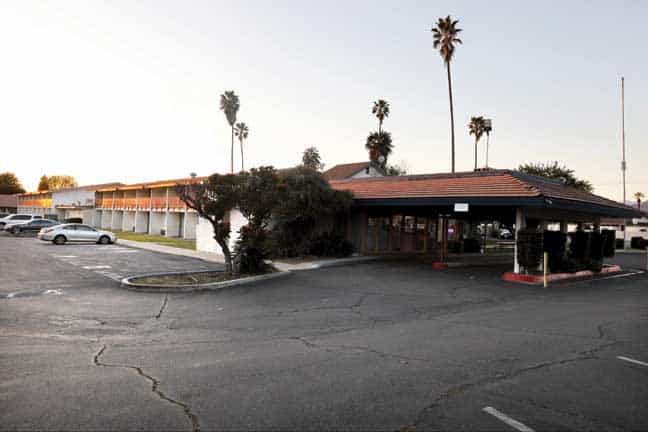Residential inn near freeway gets boost from council vote

The Claremont City Council approved an amendment to existing city code Tuesday that helps pave the way for the former Knights Inn motel to be redeveloped as a Residence Inn by Marriott. Courier photo/Steven Felschundneff
by Steven Felschundneff | steven@claremont-courier.com
Anyone who has even taken a casual look at the pages of the Claremont Courier will undoubtedly be familiar with reports of crime and other problems emanating from the motels near Indian Hill Boulevard and the 10 Freeway. On Tuesday, the Claremont City Council took a step toward redeveloping one of those motels when it approved an amendment to an existing specific plan.
By a 4-1 vote, the City Council agreed to reduce the current 60-foot setback in the code to an average of 15 feet to accommodate the proposed construction of a Residence Inn by Marriott at 721 S. Indian Hill Blvd., the location of the former Knights Inn, which is currently being operated as a University Inn.
The motel’s new owner, Ashok Patel of Sagemont Hotels and Sushil Capital, had requested an amendment to the Southwest San Jose Specific Plan, which the council passed in August 2016 in anticipation of the construction of a Hampton Inn and Suites at the location.

The Claremont City Council approved an amendment to existing city code Tuesday that helps pave the way for the former Knights Inn motel to be redeveloped as a Residence Inn by Marriott. Courier photo/Steven Felschundneff
“The Specific Plan was drafted in 2016 to accommodate the development of a four-story, 120-room hotel and additional commercial space within the plan area,” read a report from Community Development Director Brad Johnson. “The hotel envisioned when the Specific Plan was created was a long, linear hotel located behind a surface parking lot. In the intervening seven years, the previous property owner proposed to develop the new hotel (Hampton Inn), and then a remodeled and expanded hotel (possibly Best Western). The City approved both proposals, but neither was built due to concerns over their financial feasibility.”
The planned Hampton Inn was to be a long rectangular building that ran parallel to the adjacent 10 Freeway. Patel’s proposal will be more of a square shape and turn the hotel 90 degrees, necessitating the reduced setbacks to accommodate adequate parking.
City planning staff expressed confidence that, unlike previous applicants, Patel and his company would follow through, citing his long track record developing hotels for Marriott, including securing a franchise agreement for the Claremont location. Additionally, the staff report included a letter of recommendation for Patel from Robert A. Sanger, area vice president, lodging development at Marriott.
The planning commission held a public hearing on the proposed amendment on December 20 and approved the idea on a 4-3 vote. However, any change to a specific plan must be passed by a supermajority, so the amendment was forwarded to the council with a default negative declaration. Several commissioners expressed reservations about approving the amendment given there was no guarantee Patel would follow through on his plans, thus leaving the city right where it is now, with a blighted site on an important entryway intersection.
The commission’s vote meant the council also had to pass the plan with a supermajority, which it narrowly did when council member Corey Calaycay voted no.
“I am sure more than any decision I have made up here this is going to turn heads and spin some heads,” Calaycay said before casting his vote.
He expressed appreciation for how Patel has worked with the existing neighbors to come up with a plan they could support. Calaycay also agreed that the site needs to be redeveloped and he fully supports keeping the area commercial to bolster Claremont’s tax base. But in order to be consistent with his previous votes opposing tall structures in Claremont, he said he had to vote no because the proposed inn is a four-story building.
Calaycay referenced the compromise he reached with other council members approving the Village South Specific Plan, which allows five-story buildings, but expressed general reservation that the small town village feel of Claremont is compromised when such large buildings become the norm.
“I made remarks earlier, as was alluded to being supportive of business and so some may view that as hypocrisy, but I view it as a greater hypocrisy to make statement that I don’t support four-story buildings and turn around weeks after making those statements supporting a four-story development,” Calaycay said.
During public comment, Vickie Nobel, who owns a condominium across the street from the proposed hotel, said she has been to every public meeting about the development and came away with the impression that Patel would honor residents’ concerns, including lighting, the width of the driveway, and security. She said Patel expressed his desire get along with the neighbors and really listen to what they had to say about his plan.
“I was a little bit disappointed because I was one that asked for a greater setback because I am directly across the street,” Nobel said. “But I am willing to compromise on that setback being reduced because we have been promised a tree screen and privacy by the trees that will be planted.”
The proposed screen would be planted in several levels, including Brisbane box trees near the hotel, another row of medium-sized trees on the center median, at the northern curb of San Jose, and finally a set of shrubs near the condominiums’ backyards to shelter outdoor porches.
Nobel requested the trees be planted soon so they could begin to grow long before the hotel welcomes its first guests, which planning staff said could be accommodated.
The amendment to the specific plan is really just the beginning for the hotel’s progress through the approval process, which will include further public hearings before both the planning and architectural commissions.









0 Comments